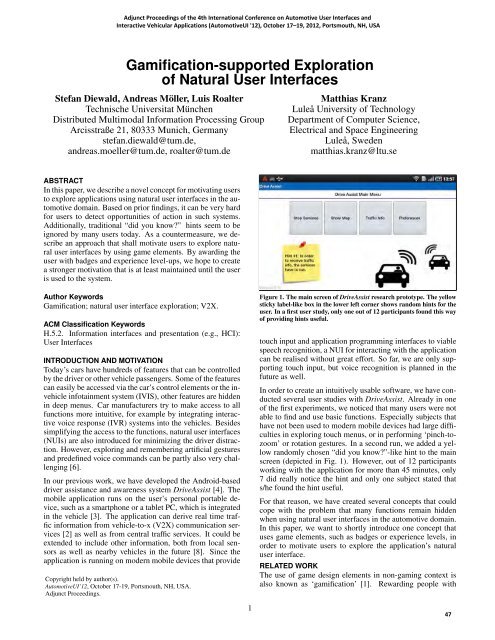12: Adjunct Proceedings - Automotive User Interfaces and ...
12: Adjunct Proceedings - Automotive User Interfaces and ...
12: Adjunct Proceedings - Automotive User Interfaces and ...
Create successful ePaper yourself
Turn your PDF publications into a flip-book with our unique Google optimized e-Paper software.
<strong>Adjunct</strong> <strong>Proceedings</strong> of the 4th International Conference on <strong>Automotive</strong> <strong>User</strong> <strong>Interfaces</strong> <strong>and</strong><br />
Interactive Vehicular Applications (<strong>Automotive</strong>UI '<strong>12</strong>), October 17–19, 20<strong>12</strong>, Portsmouth, NH, USA<br />
Gamification-supported Exploration<br />
of Natural <strong>User</strong> <strong>Interfaces</strong><br />
Stefan Diewald, Andreas Möller, Luis Roalter<br />
Technische Universitat München<br />
Distributed Multimodal Information Processing Group<br />
Arcisstraße 21, 80333 Munich, Germany<br />
stefan.diewald@tum.de,<br />
<strong>and</strong>reas.moeller@tum.de, roalter@tum.de<br />
ABSTRACT<br />
In this paper, we describe a novel concept for motivating users<br />
to explore applications using natural user interfaces in the automotive<br />
domain. Based on prior findings, it can be very hard<br />
for users to detect opportunities of action in such systems.<br />
Additionally, traditional “did you know?” hints seem to be<br />
ignored by many users today. As a countermeasure, we describe<br />
an approach that shall motivate users to explore natural<br />
user interfaces by using game elements. By awarding the<br />
user with badges <strong>and</strong> experience level-ups, we hope to create<br />
a stronger motivation that is at least maintained until the user<br />
is used to the system.<br />
Author Keywords<br />
Gamification; natural user interface exploration; V2X.<br />
ACM Classification Keywords<br />
H.5.2. Information interfaces <strong>and</strong> presentation (e.g., HCI):<br />
<strong>User</strong> <strong>Interfaces</strong><br />
INTRODUCTION AND MOTIVATION<br />
Today’s cars have hundreds of features that can be controlled<br />
by the driver or other vehicle passengers. Some of the features<br />
can easily be accessed via the car’s control elements or the invehicle<br />
infotainment system (IVIS), other features are hidden<br />
in deep menus. Car manufacturers try to make access to all<br />
functions more intuitive, for example by integrating interactive<br />
voice response (IVR) systems into the vehicles. Besides<br />
simplifying the access to the functions, natural user interfaces<br />
(NUIs) are also introduced for minimizing the driver distraction.<br />
However, exploring <strong>and</strong> remembering artificial gestures<br />
<strong>and</strong> predefined voice comm<strong>and</strong>s can be partly also very challenging<br />
[6].<br />
In our previous work, we have developed the Android-based<br />
driver assistance <strong>and</strong> awareness system DriveAssist [4]. The<br />
mobile application runs on the user’s personal portable device,<br />
such as a smartphone or a tablet PC, which is integrated<br />
in the vehicle [3]. The application can derive real time traffic<br />
information from vehicle-to-x (V2X) communication services<br />
[2] as well as from central traffic services. It could be<br />
extended to include other information, both from local sensors<br />
as well as nearby vehicles in the future [8]. Since the<br />
application is running on modern mobile devices that provide<br />
Copyright held by author(s).<br />
<strong>Automotive</strong>UI’<strong>12</strong>, October 17-19, Portsmouth, NH, USA.<br />
<strong>Adjunct</strong> <strong>Proceedings</strong>.<br />
1<br />
Matthias Kranz<br />
Lule˚a University of Technology<br />
Department of Computer Science,<br />
Electrical <strong>and</strong> Space Engineering<br />
Lule˚a, Sweden<br />
matthias.kranz@ltu.se<br />
Figure 1. The main screen of DriveAssist research prototype. The yellow<br />
sticky label-like box in the lower left corner shows r<strong>and</strong>om hints for the<br />
user. In a first user study, only one out of <strong>12</strong> participants found this way<br />
of providing hints useful.<br />
touch input <strong>and</strong> application programming interfaces to viable<br />
speech recognition, a NUI for interacting with the application<br />
can be realised without great effort. So far, we are only supporting<br />
touch input, but voice recognition is planned in the<br />
future as well.<br />
In order to create an intuitively usable software, we have conducted<br />
several user studies with DriveAssist. Already in one<br />
of the first experiments, we noticed that many users were not<br />
able to find <strong>and</strong> use basic functions. Especially subjects that<br />
have not been used to modern mobile devices had large difficulties<br />
in exploring touch menus, or in performing ‘pinch-tozoom’<br />
or rotation gestures. In a second run, we added a yellow<br />
r<strong>and</strong>omly chosen “did you know?”-like hint to the main<br />
screen (depicted in Fig. 1). However, out of <strong>12</strong> participants<br />
working with the application for more than 45 minutes, only<br />
7 did really notice the hint <strong>and</strong> only one subject stated that<br />
s/he found the hint useful.<br />
For that reason, we have created several concepts that could<br />
cope with the problem that many functions remain hidden<br />
when using natural user interfaces in the automotive domain.<br />
In this paper, we want to shortly introduce one concept that<br />
uses game elements, such as badges or experience levels, in<br />
order to motivate users to explore the application’s natural<br />
user interface.<br />
RELATED WORK<br />
The use of game design elements in non-gaming context is<br />
also known as ‘gamification’ [1]. Rewarding people with<br />
47





